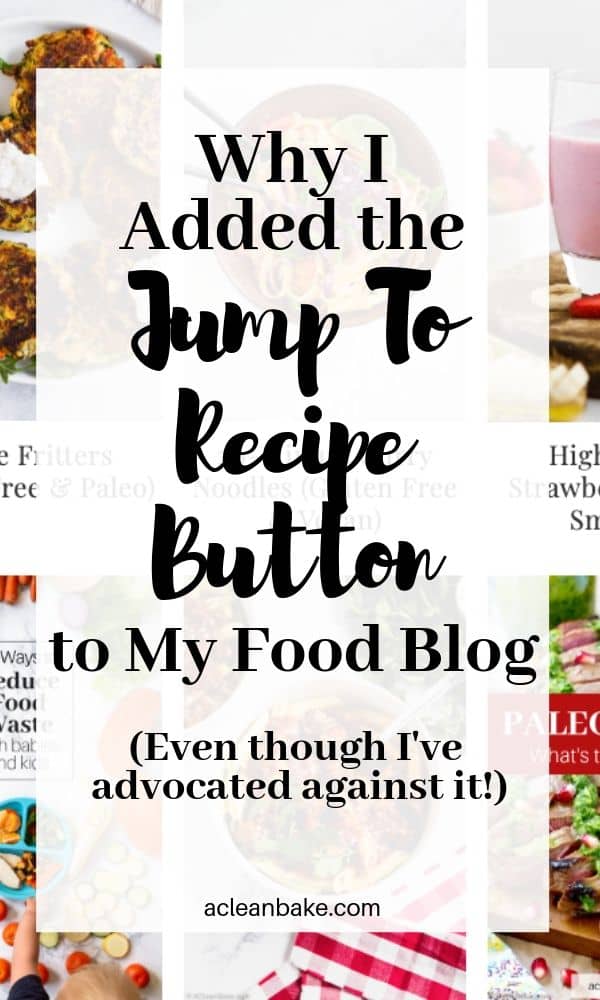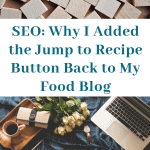If you’re a food blogger, you’ve heard a lot about the Jump To Recipe button. I’ve talked about it here before, and – let’s face it – it’s the topic of many heated debates among the blogging and SEO community, both online and offline.
Last month, at the Mediavine Conference, it came up in casual conversation more than once. I mean, yes, we’re nerds, but it’s also a really critical factor in how users engage with, and Google views, your food blog.
I’ve expressed my doubt about the button before, and proposed a limited number of scenarios in which it would be appropriate – but you may notice that all of the recipe pages on my site now display the Jump to Recipe button.
What’s changed?

Well, I made the decision to add the Jump to Recipe button for four important reasons.
To test my hypothesis
In my last post about the Jump button, I suggested that the button wasn’t a great idea for many bloggers, especially those who, like me, rely on ad income to fund their blog. I also suggested that there is no SEO benefit, except in very limited circumstances.
Now, I’m trying to disprove my own hypothesis.
First, when I asked my ad network, Mediavine, for some hard data to support their very strong contention that the Jump button reduces your RPM, and to give me an idea of how much a blogger can expect their RPM to decline, they couldn’t give me an answer. They said it is “just not possible to give a ballpark. The reason being is that there are so many factors that come into play, mainly how mainly how many readers are actually using it.”
I characterized it, and they confirmed, as varying from “a negligible impact to a major decline, but can only be assessed on a site-by-site basis (i.e. there is no way to predict)”. So, in other words, it might not have much of an impact on my site at all. Summer is a notoriously lower-traffic (and therefore, lower-income) season of the year, so this seemed like a good time to try it out.
Because Google Likes It (Maybe)
As you may or may not know, I track my traffic, social following, and keyword rankings on a regular basis. It used to be weekly, but that was making me a little obsess-y, so I switched to monthly tracking (which, by the way, is more meaningful, since SEO is a long game).
Over the course of the last couple of weeks, I noticed a few surprising ranking gains since the latest Google algorithm update in early June, and they were all on pages that had the Jump button activated. Everyone agrees that Google doesn’t explicitly look for the Jump button and reward bloggers for using it, but it was a very clear pattern that I couldn’t ignore.
It may be that Google has gotten better at indirectly rewarding good UX (user experience). They already directly reward UX in many ways, with site speed being the most explicit. They also like to see that your site offers useful information, your recipe is coded a certain way (that’s why food bloggers use recipe card plugins), and your ads load in certain places (for example, Google hates to see an ad above your header).
I’ve noticed a recent uptick in chatter about the importance of UX (user experience) among the SEO community, peaked my curiosity about using the button throughout my entire site.
Because You Like It
After I posted the first article about the Jump button, I was stunned by the amount of passionate feedback I got from readers who said they prefer the button. You made some great points:
- If you’re a house with food allergies or intolerances, the first thing you need to know is whether the recipe includes something you can’t eat.
- If you’re a serious cook, you want to make sure the recipe is good quality before you even think about adding it to your menu.
- If you’re looking for a specific kind of recipe, you want to make sure it is what it promises to be.
Basically, you want to vet the recipe before you commit a lot of time to reading the introduction. That’s totally fair.
I was especially heartened by the reader who told me that they use the jump button to vet the recipe, and then goes back and reads the introductory text if they decide the recipe is appealing to them. (If that was you, thank you! I work very hard on the introductions to the recipes, and include lots of useful information. I appreciate you reading it in a way that works for you!)
Ultimately, I want these recipes to be as useful for you as possible, so if interacting with the recipe first, then reading the editorial portion (hopefully) is what you prefer, then I’d like to give it to you.
Because I Like It
Here’s the thing: I realized that, more and more, I was personally using (and appreciated) other bloggers’ jump buttons. And then I realized that, if I appreciated it on others’ sites, you all deserve it on my site.
So, I added it.
Let’s Jump (get it?) In
There is no better way to know how the Jump button will affect a site than to just give it a try and track carefully. I added the jump button today, 7/12/19, and I’ll see how it works out over the course of the next 3 months or so.
Stay tuned.


Kristina says
Hey! Love your blogger resources posts but there’s no easy way to find them on your site — not in your header menu or sidebar or front page. Is there an easy link to get to your blogging resources category?
Nora (A Clean Bake) says
Hi Kristina! It was buried in a sub-menu so I moved it to the main menu at the top (before “recipes”). Thanks for pointing that out!
Caitlin says
Love this! I found myself using Jump to Recipe links often a few years ago, so 2-3 years ago I started adding them to my site. In fact, I sometimes add it mid-post as well. I know some people love reading long posts, but others couldn’t care less. I think adding the button helps appeal to those who just want to check the ingredients, but still allows me to feel comfortable putting tons of information in the post for those who want it. I didn’t do a before and after, so I’m excited to see results from your test! Thanks Nora! – Caitlin
Nora (A Clean Bake) says
You’re welcome! So glad it was helpful!
Stacey says
Hello
I would love to know how your trial with the jump to button is going
Nora (A Clean Bake) says
I’m a convert! Readers have said they really appreciate the button, and I use it myself. My RPM has mayyyybe dipped a teeny bit but nothing that concerns me. My organic traffic has risen (not solely due to the jump button but that may be one factor). I have no plans to remove it.
Rachel says
Hey Nora! I wonder how this has affected your RPM and if you plan to continue to use it? I see Mediavine now offer a way to do it, but have warned against lower income. What have you seen?
Nora (A Clean Bake) says
I haven’t been able to collect historical data to do a year over year comparison on RPM, but anecdotally I can tell you that I haven’t seen a drastic effect on RPM. If anything there has been a teeeeeensy decline but I haven’t been concerned because my organic traffic has increased (whether or not that is due to the Jump button is the question; I don’t think it is the sole reason for the increase) to compensate.
Sid Brow says
What I really hate our acronyms ! Why can’t you just say the word ! Like what does RMG MEAN?
Nora (A Clean Bake) says
I don’t know what RMG means. Your comment is the only place on the page it occurs.
Sherry M says
I think Sid Brow meant RPM but mistyped. You state “First, when I asked my ad network, Mediavine, for some hard data to support their very strong contention that the Jump button reduces your RPM, and to give me an idea of how much a blogger can expect their RPM to decline, they couldn’t give me an answer. They said it is “just not possible to give a ballpark.” What does RPM mean? Is this in reference to bounce rate? It’s been a couple years since this post, are you still pro-jump button?
Nora (A Clean Bake) says
RPM means revenue per thousand, as in how much you make per one thousand sets of eyeballs that see your ad!
And yes, I am still pro-jump button. Mediavine has actually changed their stance to be pro-jump button too! Here is their article about it: https://www.mediavine.com/create-jump-to-recipe-is-here/